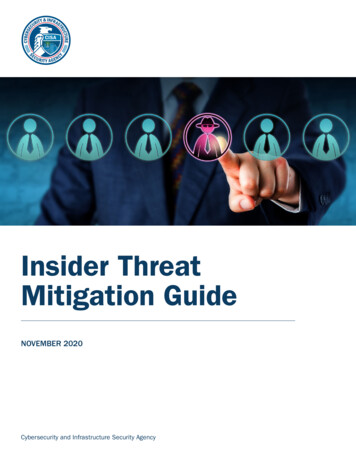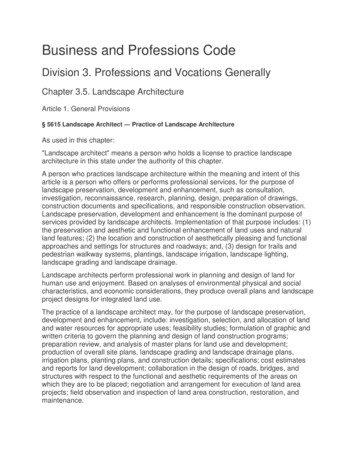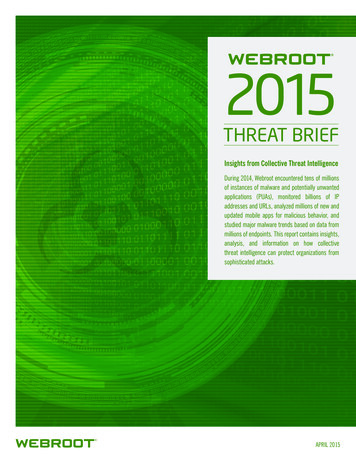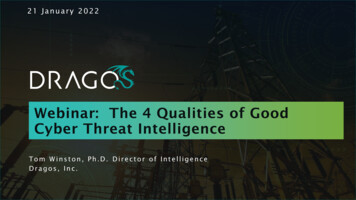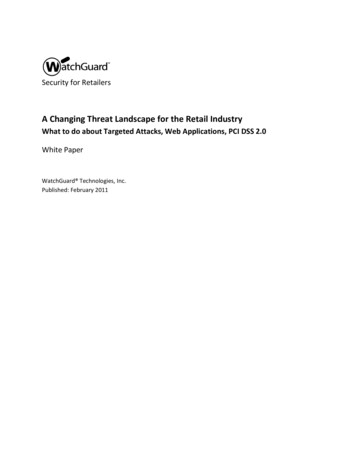
Transcription
Security for RetailersA Changing Threat Landscape for the Retail IndustryWhat to do about Targeted Attacks, Web Applications, PCI DSS 2.0White PaperWatchGuard Technologies, Inc.Published: February 2011
Retailers Are Under AttackThe recent, unprecedented upsurge in attacks on retail businesses makes it clear that cyber criminalshave now turned more of their attention – and formidable skills – to cashing in on the sector’s rich cacheof confidential data.According to MessageLabs, the number of attacks that specifically targeted the retail sector jumped to516 in just one month during Q4 2010, compared to the earlier average of 7 attacks per month for muchof that same year. 1 It also marked the first time in recent years that the retail sector became the focusof a major targeted attack campaign.It’s All about the DataCyber criminals follow the money. Credit card numbers and other forms of personal data make the retailindustry a particularly lucrative target. Harvesting customer information, of course, is not new to theindustry. The infamous 2007 hack of TJX Companies Inc. resulted in the theft of 45.7 million credit anddebit card numbers, with an estimated cost to the company of 216 million. What started as a poorlysecured wireless connection eventually opened the door to complete access to the TJX databases.The graph below shows how retail has compared to other industries over the last few years, based onthe percentage of records/people affected by a data breach. At 31%, retail trails financial services onlyslightly (33%) for the highest number of people affected by data breaches. (Source: KPMG’s Data LossBarometer http://www.datalossbarometer.com/index.html)Figure 1. Retail is Second in the Number of Records/People Affected1MessageLabs Intelligence Report, October 2010, http://www.messagelabs.com/resources/press/617752 P a g eCopyright 2011 WatchGuard Technologies
Recent Attacks Show Increasing SophisticationOne of the most disturbing trends for the retail sector is what’s known as the “targeted attack.” In thepast, most attacks involving email were widely distributed, using indiscriminate mass mailings to castthe broadest net. Targeted attacks, on the other hand, are characterized by low-volume distribution.Organizations are selected and researched before highly sophisticated social engineering scams areexecuted to gain access to sensitive data.Spear PhishingOne targeted attack strategy involves a technique called“spear phishing.” Simple “phishing” exploits are impersonalspam emails aimed at tricking victims into giving up sensitivedata. However, spear phishing is much more refined andcarefully crafted, using some form of personalizedinformation in the email to make the recipient think themessage is from a reputable and trusted source. Moreimportant, spear phishing is targeted towards a specificorganization or individual. Spear phishers typically target“whales,” which are high-level individuals at an organization– for instance, C-level executives.BLEEDING EDGE TARGETED ATTACKSAdvanced Persistent Threats (APTs) arethe new high-end of targeted attacks.There is no single, standard definition ofAPTs, but they do have these things incommon: APTs apply the most advancedattack, infection, and malwarepropagation techniques known. They are designed to stay hiddenwithin a victim network or host for along period of time – typically hidingbehind strong rootkit technology,cleaning logs, and slow, quietCommand and Control channels.How do scammers get the personal information for theattack? There is a great deal of data available on the web They tend to have a specific,that criminals can use. Personal info is easily harvestedtargeted goal in mind. For instance,these days from blogs, social networking sites such asthey might be designed to slowlyFacebook and Twitter, or from a business’s web site itself.steal intellectual property from aspecific business or quietly takeIt’s as uncomplicated as searching for blog postings aboutcontrol of a retailer’s network adminbuying certain products, monitoring LinkedIn for people who2privileges.work for a particular organization, or capturing the names offriends on Facebook pages. One report revealed that 324 spearphishing attacks against 88 employees of the same company appeared to come from their seniorexecutive email addresses – addresses most likely gleaned from professional networking sites. 3The following example of a targeted spear phishing attack highlights the growing menace posed byexploits involving retail. It relied on the much-talked about Zeus botnet. “Zeus” is actually a family ofmalware designed to steal data. At one time it was used mostly to target online banking sites, but bymid-2010 it was reported that up to 88 percent of Fortune 500 companies showed Zeus botnet activity. 42WatchGuard 2011 Network Security Predictions,www.watchguard.com/docs/brochure/wg 2011 security predictions.pdf3Zeus botnet targeting Macy's, Nordstrom account holders, SC Magazine, December 09, 9/4CNET News, April 14, 2010, http://news.cnet.com/8301-27080 3-20002425-245.html#ixzz1A6sCBtC43 P a g eCopyright 2011 WatchGuard Technologies
In late 2010, researchers discovered a Zeus botnet that was targeting credit card accounts ofmajor retailers, including Macy’s and Nordstrom. Although other versions of Zeus have beenknown since 2007, this attack used a Zeus 2.1.0.8 botnet – the most sophisticated version of Zeusto date, in an exploit specifically crafted to steal credit card information at the retailer’s gateway.The attack relied on a social engineering scheme that took advantage of the trust relationshipbetween customer and merchant. The victim would receive a highly plausible email that appearedto come from the retailer, containing a link to the merchant’s web site – www.macys.com, forexample. When the unsuspecting victim connected to the web site, Zeus malware would inject alegitimate-looking, man-in-the-middle pop-up (see Figure 2) that requested personally identifiableinformation. Attackers use forms such as this to gather additional personal information alongwith the customer’s credit card number. This not only opens the door to identify theft, it givesattackers what they need to bypass fraud detection measures that could be used by the merchantto investigate suspicious transactions. (Source: Help Net Security, December 2010)Figure 2: Fraudulent pop-up window from Zeus botnet/phishing exploit.At the same time that Zeus was collecting personal data via a retail-oriented spear phishing exploit,massive cyber attacks were hitting other retail/hospitality organizations as large as McDonalds andWalgreens, forcing them to notify customers that their personal information may have beencompromised. 55Retailers Come Under Cyber Attacks, December 21, 2010, eUnder-Cyber-Attack571644 P a g eCopyright 2011 WatchGuard Technologies
Customers Expect a Great Deal from YouIn the world of retail it’s no longer enough to provide apleasant customer experience. Retailers need to extend theconcept of customer service to looking after a customer’spersonal data after the transaction is completed. There’smore at stake than just PCI compliance. Security and trusthave been described as the backbone of doing business overthe Internet. Customers need to feel that they can rely onthe merchants they do business with to have stringentsecurity measures in place to prevent data theft.WHO’S SPOOFING YOUR DOMAIN?Has your business’s online reputationbeen compromised? Check yourreputation score on the WatchGuardReputation Enabled Defense web page.Reputation Enabled Defense is thepowerful cloud-based engine thatgathers data from millions of globalsources and deployed systemsworldwide to identify and block spam,malware, and malicious threats in realtime.There are more than 57,000 illegitimate web sites createdBy cross-referencing and analyzing data6from global feeds across multipleeach week. Most of these malicious sites mimic prominentprotocols, this technology provides anweb sites in an attempt to fool the web-browsing public.all-encompassing view of the IP addressPerhaps more worrisome to retailers are the number ofbehavior and URL threat risk level.legitimate web sites that have been infected with malware,Reputation Enabled Defense technologymaking them possible distribution centers of malware foris integrated into WatchGuard securitycustomers, employees, and partners. In other words, yoursolutions. Read more on page 8.retail business web site, unbeknownst to you, could becomeinfected – or may even be infected now – with malware that can,in turn, infect your stakeholders’ computers as well as steal their data.How Safe Are You?The size of your retail business doesn’t matter. Any data you collect is big business. In 2010, credit cardinformation was the most commonly advertised item for sale on underground black-market servers,accounting for 23 percent of all goods and services. 7 Every merchant that connects to the Internet is apotential target of cyber crime.Unfortunately, there is nothing you can do if customers fall victim to scams that fraudulently presentyour business’s name to gain their trust. That falls in the area of your customers’ own security measuresand the safeguards they employ. But there are plenty of ways that retail businesses can ensure theirweb sites and data are protected. Cyber criminals target weak network configurations, vulnerabilities insoftware applications (particularly Web 2.0 apps), unencrypted data in motion, and gaps in networksecurity deployments; these are all areas where you can ensure you have strong protection.Today’s businesses are becoming more concerned and better informed about the cyber threatlandscape, and are increasingly seeking security solutions that better protect their own and theircustomers’ data.6“The Criminal in Your Browser Is Real,” Help Net Security, December 2010 , http://www.netsecurity.org/article.php?id 1549&p 372010 Annual Security Report, MessageLabs, http://www.messagelabs.com/globalthreats5 P a g eCopyright 2011 WatchGuard Technologies
How WatchGuard Keeps Your Retail Business ProtectedThe key to security is multi-layered, multifaceted defenses. Below are five steps to better security youcan’t afford to ignore on your network – from application control to data loss prevention – to ensureyour retail business stays in business.1. Control Applications on Your NetworkEmployees in all industries are turning more and more to the web to communicate, share files, interactwith blogs, etc. Retail businesses are no exception. Facebook, Twitter, Hotmail, YouTube, MSNMessenger – there are hundreds and hundreds of these web applications. While some are useful, manyare non-productive and all of them can potentially carry threats. Web apps pose unique securityproblems for your network because they allow users to interact and exchange data via online tools thatbypass traditional network controls. To a conventional firewall, it just looks like regular web traffic.You Need Granular Control That Is Easy to ManageIS IT SAFE FOR RETAIL TO SKYPE?Outright blocking of every web application is possible, butproblematic. True, these apps are notoriously unsecure –but there are concrete business reasons to allow sometypes of access.Around 37 percent of businesses useSkype to communicate and conduct10video conferences. It’s free, featurerich, and easily accessible. But Is it safefor your employees to use?For example, your business may maintain a presence onFacebook, which has over 500 million active usersworldwide, 8 as a way to reach out to customers. The sheersize of the social network makes it an attractive, low-costmarketing vehicle. You can’t completely block Facebook onyour network if you need to maintain a Facebook page.What you require is a solution that allows fine-grainedcontrol over which applications your employees can access.With WatchGuard Application Control 9 protecting yournetwork you can easily define by domain, group, orindividual user who may use Facebook. Instant messaging with Skype canbe a source of malware and spam File transfer could be a source ofinfection from viruses File transfer could be used totransfer sensitive data outside theorganization Idle chat and calls could becomemajor productivity issuesWatchGuard Application Control extends this granularcontrol over more than 1,800 web and businessapplications, managed from an easy-to-use centralizedconsole that organizes applications by categories andTo block or not to block – that’s thebusiness owner’s dilemma.WatchGuard Application Control letsyou move beyond the restrictive “on oroff” option. It allows you to actuallycontrol Skype on your network to takeadvantage of the technology when itmakes good business sense anddisallow it when it doesn’t.8Facebook: Facts & Figures For 2010, March 22, 2010, DigitalBuzz blog, facts-figures-for-2010/9For more information about WatchGuard Application Control read “Take Back Control: Increase Security,Empower Employees, Protect the Business” at rs/application-control.asp?t freg10“Skype By the Numbers” Gigaom, April 20, 2010, 6 P a g eCopyright 2011 WatchGuard Technologies
subcategories for simple setup and quick configuration changes as your usage policies are refined.For the Facebook example above, your IT administrator could easily drill down with a few clicks in theApplication Control “social media” category, select Facebook and grant access only to the marketingteam, but disallow the use of time-wasting Facebook games and chat with just a few more clicks into thesubcategories. With steps as simple as these, you can finally begin to take back control of your network.2. Keep the Bad Guys Out of Your InboxWhen it comes to spam the sheer volume is staggering, with billions of emails per day, accounting for 89percent of all email sent worldwide. 11 Some think of spam as a vast nuisance that clogs networks andwastes time, but a far greater problem is the pervasive risk of attack.As a delivery mechanism, spam is utilized by attackers several ways. Malware can be contained within the message itself.For example, an email might include an attachment that, ifopened, launches a network intrusion, or a malicious programmight be initiated simply by opening an HTML email message.Spam messages can be free of malware but contain embeddedURLs. Clicking these links takes unsuspecting users to maliciousweb sites where drive-by downloads await.EMAIL STATS AT A GLANCETallied at the close of 2010,these statistics show whyemail has so much appeal forcyber crooks. 294 billion – Averagenumber of email messagessent per dayWhat’s a Drive-by Download? 262 billion – The numberof spam emails per day“Drive-by downloads” are triggered by visiting an infected web sitewhere malicious software automatically downloads and installs on thevictim’s computer. This happens in the background without the victim’sknowledge. The infected computer then becomes host to malware thatmight be designed to steal data, log keystrokes, or even launch morespam attacks via the victim’s network. 1.88 billion – The numberof email users worldwideThe SolutionIf you can prevent malicious messages from entering your network in thefirst place, then you never have to deal with the serious consequences ofa successful exploit. 480 million – New emailusers since the year before 2.9 billion – The numberof email accountsworldwide 25 percent – Share ofemail accounts that arecorporate(Source: Venture Beat Jan 2011)WatchGuard provides exceptionally strong anti-spam technology to keepthe ceaseless barrage of messages at bay. WatchGuard products have tools that block nearly 100percent of unwanted emails, recognizing and stopping spam regardless of the language, format, orcontent of the message – even image-based spam that other anti-spam products often miss. This takesthe heat off your email servers by stopping spam and email-borne threats at the perimeter of thenetwork. It provides the solid protection your business needs, while saving you from the burden ofprocessing massive amounts of unwanted email.11“2010: the year in internet stats,” Venture Beat, January 12, 2011, internet-stats/7 P a g eCopyright 2011 WatchGuard Technologies
Why Reputation MattersOne of the highly effective tools that WatchGuard uses to stop spam is its Reputation Enabled Defense.Reputation Enabled Defense gathers data from millions of global sources and deployed systemsworldwide, including major anti-virus engines, to identify spam in real time. Its sophisticated nextgeneration technology analyzes the risk level of incoming email, blocking upwards of 95 percent of spambefore it enters the network.This innovative “in the cloud” anti-spam engine examines sender information and content, includingattachments and embedded URLs. It automatically conducts contextual analysis of message traffic todetermine the message’s safety score for highly intelligent protection.Bad emails are detected and blocked immediately. Suspect mail is directed to a secure spam quarantinewhere users can manage their quarantined messages, safe lists, and block lists from an easy-to-useinterface for maximum flexibility.Reputation Enabled Defense is a “connection level” block. Many anti-spam solutions that don’t have adynamic reputation authority like WatchGuard’s have to let your email server receive and startprocessing the spam email before the solution can analyze it and decide whether or not it’s spam. Whilethese solutions may eventually block the unwanted messages, your email server still has to useresources for partially processing that email. Reputation Enabled Defense blocks spammer addresses atthe FIRST packet, before an email connection is even complete. That means that not only is spamstopped, but your email server does not need to waste resources processing spam.3. Tighten Web SecurityThere are more than 255 million web sites now with 21.4 million added just last year. 12 The number ofmalicious web sites has increased 111.4 percent, with 79.9 percent of the infected web sites identifiedas legitimate sites that have been compromised. 13 The web has become the primary attack vector fordistributing malicious code. This is a precarious situation for merchants attempting to do business in anonline environment. Good web security is a must.“Web security” is actually a blanket term that includes a variety of network defenses. After all, the webis a big place; good web security has to cover a lot of territory. Below are three important securitycapabilities that retail businesses should layer on to have the level of web protection they need. URL FilteringUnlimited web access can greatly impact productivity in the workplace, and inappropriate websurfing can violate acceptable use policies and lead to lawsuits. Above all, unfettered web accessopens the network to attack. Keep in mind, there’s a strong correlation between sketchy web12Venture Beat -internet-stats/State of Internet Security, t-state-of-internet-security-q3-q4-2009.aspx138 P a g eCopyright 2011 WatchGuard Technologies
content and risk. For instance, researchers have repeatedly found that sites with sexually explicitcontent are the number one web site category most likely to include malware. 14WatchGuard makes it easy to block whole categories of unacceptable content types. With a fewclicks of the mouse IT administrators can choose from a menu of web categories to select thetype of content they deem inappropria
At one time it was used mostly to target online banking sites, but by . major retailers, including Macy’s and Nordstrom. Although other versions of Zeus have been known since 2007, this attack used a Zeu


